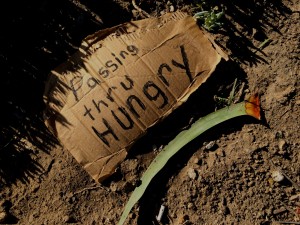In the early 1990’s, I volunteered to photograph people who live on the streets for an amateur documentary. For this project, I used black and white photography, and hand colored the images.
Within a few minutes after my arrival downtown, I was threatened, at first with a six foot metal pipe, then someone offered to slash my tires, another called me names.
I was frightened.
I was told I could photograph my slashed tires. Realizing I had no power, nor did he, I said, “You can slash my tires, but I will not photograph it, I am not here for that.”
Although shaking, I refused to give up. I kept listening to the fear of those who do not have a door to lock. I heard about the coercion they felt that often accompanied the handouts, most likely a long stereotypical sermon.
At the end, after time, I was trusted. Several people actually set up their own photo scenes to demonstrate their addiction, or poverty, or loneliness.
Two men, the one with the metal pipe, and the one who threatened to slash my tires, apologized. The largest man grabbed both my hands in his and said, “God Bless You!!!
I see these signs, like the photograph I took this week, and I think of them, their humility and their kindnesses to me in spite of their fear and despair.
This is why I ask clients to bring in their photographs to the counseling session. There are times that words are not enough. There are times that memory is encoded in image rather than language. There are times that the experience has only a few words attached to it and therefore cannot be adequately described without an image.
How much more does my story above of the homeless people mean to you, with the photograph? How much less would my story mean to you, without my photograph?
As clients grow and mature in counseling, they become less focused on petty concerns and more aware and attentive to global suffering. This has been observed in people from all walks of life including a study of men in prison, after a period of intensive neurotherapy. (Elmer Green, PhD).
The basic tenet of existential phenomenology, whether counseling or research, is to find meaning and purpose. Victor Frankl, describes his theoretical attention to the importance of meaning as a different developmental stage than the work of Freud or Adler. He stated that Freud’s concept of the “will to pleasure,” is the focus of the developmental stage of childhood, and that Adler’s concept and focus of “will to power,” is the developmental stage of adolescence. Frankl’s attention on the “will to meaning,” is an adult stage of development.
Frankl states, “In some way, suffering ceases to be suffering at the moment it finds a meaning”.
Bruce Douglas and Clark Moustakas (1985), wrote about existential processes, “Through disciplined focus on the structure of experience (e.g., time, space, materiality, causality, interpersonal factors), the phenomenological investigation attempts to reveal the actual nature and meaning of an event, perception, or occurrence, just as it appears” (p. 43).
There are times that a photograph is essential to the process of focus, attention, exploration, revelation, and meaning.


